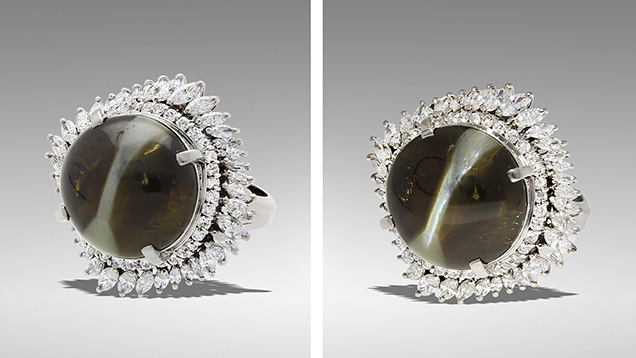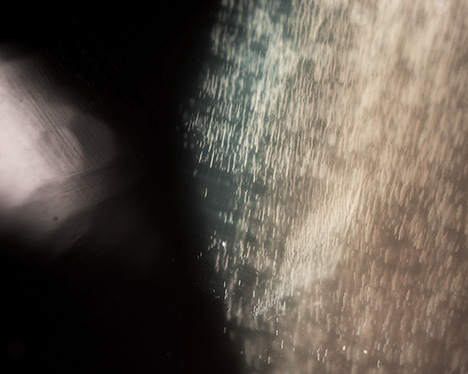Color-Zoned Cat’s-Eye Chrysoberyl

Chatoyancy occurs when light is reflected from certain oriented inclusions in a cabochon-cut gemstone. To be chatoyant, a group of fibers or needles or other reflective inclusions must be oriented parallel to the cabochon base. Usually these fibers and/or needles are dense and included throughout the stone, but occasionally there are cases with localized distribution of such inclusions.
GIA’s Tokyo laboratory examined a brownish green cabochon set in a ring with numerous near-colorless round and marquise brilliant cut accent stones. The center stone showed pleochroism and a spot RI reading of 1.75. The spectrum observed with a handheld spectroscope clearly showed the 444 nm band, consistent with green/yellow cat’s-eye chrysoberyl. Natural inclusions were observed under the microscope, as described later. For confirmation, an FTIR spectrum was collected; it showed peaks at 2163, 2403, and 4150 cm–1 that are characteristic of natural chrysoberyl (C.M. Stockton and R.E. Kane, “The distinction of natural from synthetic alexandrite by infrared spectroscopy,” Spring 1988 G&G, pp. 44–46).

In this stone, we can see obvious color zoning with a fixed whitish band in the middle between transparent brownish green portions (figure 1, left). This white part is semi-transparent/translucent due to dense clouds with minute fibrous inclusions (figure 2)—these features typically cause chatoyancy in cat’s-eye chrysoberyl. The cloud inclusions were not only on the cabochon surface but also located below the surface. As shown in figure 1 (right), this stone displayed distinct chatoyancy in the white zone. Even when viewed from an off-center direction, reflected light striking the clouds below the surface created the weak chatoyancy in the brownish green portions, which had no clouds or fibrous inclusions.
For the purpose of showing phenomena, stones with such localized inclusions can sometimes be oriented to place the inclusions at the base of the cabochon (Winter 2017 Lab Notes, pp. 459–460). Uneven distribution of included zones requires careful observation of the inclusion to likewise produce a good chatoyancy effect. This type of localized inclusion can sometimes lead cutters to be creative to maximize the appearance of the stone and the phenomenon.
.jpg)


